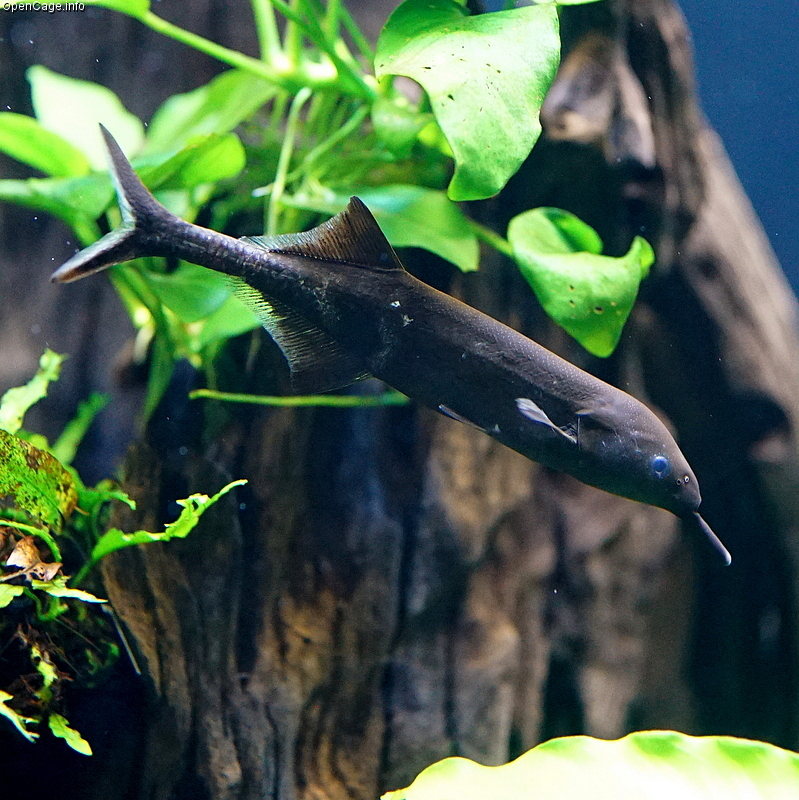
Elephant Nose Fish – Gnathonemus petersii
Elephant Nose Fish – Gnathonemus petersii. They appear thin and oblong with colors ranging from dark brown or gray with white markings.
The name elephant nose, obviously comes from the similar look its nose has compared to the trunk of an elephant.
A weak electrical organ at the thin part of body where the tail attaches, is used for sensing. This helps the elephant nose fish to communicate with other fish, detect predators and foods. These fish can feel the slightest movements when the field around them is disturbed. Because the elephant nose fish – gnathonemus petersii is nocturnal, it can move through shady or murky water, even at night.
Sexing these fish is done by an advanced hobbyist or aquatic professional. They would have to define the sex of the fish through an examination of their electrical field. Interesting.
Truly a beautiful fish.
More About Elephant Nose Fish:
Common Name: Elephant Nose Fish, Peters Elephant nose
Scientific Name: Gnathonemus petersii
Size: 8 inches / 20 cm
Natural Habitat: Niger, Mali, Nigeria, Central African Republic, Cameroon, Republic of Congo, Chad, Zambia, Benin, Democratic Republic of Congo.
Ideal Tank: Dimly lit aquarium lighting preferred as they are nocturnal. Using smooth elements such as driftwood and mopani wood is recommended. Clay pots and acrylic fish pipes are great for hiding places.
These fish have delicate flexible, tubular shaped mouths that they use to burrow themselves into the substrate. Using sand as a substrate is recommended for the Elephant Nose Fish – Gnathonemus petersii for safety of the fish and for easy burrowing.
Choosing low-light plants is recommended as they prefer dim light. Some examples to add are Anubias sp. and Vallisneria. Plants are always great in any aquarium. It adds color and a little nature! Plants also help in filtering your water when pairing it with other filtration equipment for your tropical fish aquarium.
Aquarium Size: 60 gallon+
Aquarium Water Temperature: 73 – 82 °F/23 – 28°C
Aquarium Water pH: Range pH 6.0 – 7.5
Tank Mates: Elephant Nose Fish — Gnathonemus petersii known to be territorial but at other times can be peaceful.
Small Synodontis catfish, Birchers, Ctenopoma species, African Butterfly Fish. Cichlids like Satanoperca, some Geophaus and Angelfish. Provide a natural environment for your fish. Create hiding spots in the aquarium for cover to reduce stress on your fish.
Whenever adding fish to a tank, we recommend using Prime by Seachem.
Care Level: Intermediate+
What Do I Feed My Elephant Nose Fish
- Live food
- Frozen foods
- Dried foods
- Dried worms
- It is recommended by TailsNTeeth to provide a variety of food types to your fish
Other Considerations: Elephant Nose Fish – Gnathonemus petersii is a scaleless freshwater fish. This tropical freshwater fish is sensitive to poor water conditions and aquatic fish medications. It is important to do regular water changes.
TailsNTeeth Recommends:
Using an aquarium water testing kit will ensure aquarium water parameters are suitable for these fish. The frequency of their electrical discharges increases as the water conditions become more polluted.
